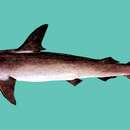Diagnostic Description
(
Inglês
)
fornecido por Fishbase
A large hammerhead without a notch at the center of the curved headhead (Ref. 58085); but with prominent lateral indentations; prenarial grooves well-developed; snout short, 1/5 to less than a third of head width; mouth broadly arched (Ref. 114967); the first dorsal fin is moderately high, te second dorsal and pelvic fins are low. Colour olive-grey or dark grey above, white belowm, and the undersides of the pectoral fin tips dusky (Ref. 58085),
- licença
- cc-by-nc
- direitos autorais
- FishBase
- Recorder
- Cristina V. Garilao
Life Cycle
(
Inglês
)
fornecido por Fishbase
Viviparous, placental (Ref. 50449), with 20 to 50 young per litter (Ref. 6871)after a gestation period of 10-11 months (Ref.58048). Size at birth between 50-60 cm TL (Ref. 13562).
- licença
- cc-by-nc
- direitos autorais
- FishBase
Migration
(
Inglês
)
fornecido por Fishbase
Oceanodromous. Migrating within oceans typically between spawning and different feeding areas, as tunas do. Migrations should be cyclical and predictable and cover more than 100 km.
- licença
- cc-by-nc
- direitos autorais
- FishBase
- Recorder
- Kent E. Carpenter
Morphology
(
Inglês
)
fornecido por Fishbase
Dorsal spines (total): 0; Dorsal soft rays (total): 0; Analspines: 0; Analsoft rays: 0
- licença
- cc-by-nc
- direitos autorais
- FishBase
- Recorder
- Cristina V. Garilao
Trophic Strategy
(
Inglês
)
fornecido por Fishbase
A carnivore (Ref. 9137).
- licença
- cc-by-nc
- direitos autorais
- FishBase
Biology
(
Inglês
)
fornecido por Fishbase
Occurs inshore and well offshore (Ref. 5578), over continental and insular shelves (Ref. 244). Coastal, pelagic, and semi-oceanic, but often bottom associated at 1-139 m (Ref. 58302). Migrates northward in summer; young often in large aggregations of hundreds of individuals (Ref. 13562). Prefers to feed on small sharks, skates and stingrays, but also preys on bony fishes, shrimps, crabs, barnacles and cephalopods (Ref. 244). Viviparous (Ref. 50449). Regarded as being dangerous to people, though only few can be tentatively attributed to this species due to its occurrence in temperate waters (Ref. 244). Reported to cause poisoning (Ref. 4690). Caught occasionally by shark and tuna longline fisheries (Ref.58048). Meat utilized fresh, dried-salted, and possibly smoked for human consumption; liver oil for vitamins, fins for soup, hide for leather, and carcasses for fishmeal (Ref. 244). Used in Chinese medicine (Ref. 12166). Become sexually mature when 250 to 300 cm long. The female gives birth to 30 - 40 young (Ref. 35388).
- licença
- cc-by-nc
- direitos autorais
- FishBase
- Recorder
- Kent E. Carpenter
Importance
(
Inglês
)
fornecido por Fishbase
fisheries: commercial; gamefish: yes
- licença
- cc-by-nc
- direitos autorais
- FishBase
- Recorder
- Kent E. Carpenter

